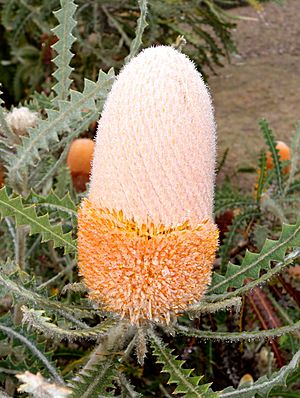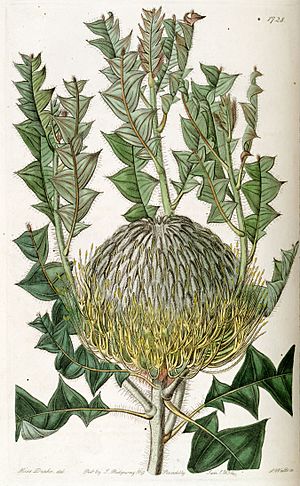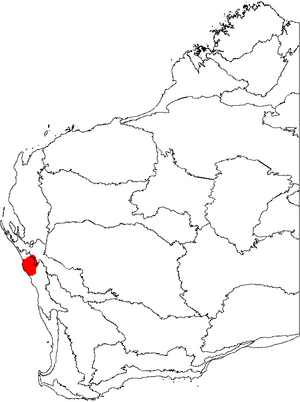Woolly Orange Banksia facts for kids
Quick facts for kids Woolly Orange Banksia |
|
|---|---|
 |
|
| Scientific classification | |
| Kingdom: | |
| (unranked): | |
| (unranked): | |
| Order: | |
| Family: | |
| Genus: | |
| Species: |
B. victoriae
|
| Binomial name | |
| Banksia victoriae Meisn.
|
|
The Woolly Orange Banksia (Banksia victoriae) is a type of large bush or small tree found in Western Australia. It grows mostly between the towns of Northampton, Western Australia and Kalbarri, and sometimes a bit further north in the Zuytdorp Nature Reserve. It's part of the Banksia plant family, known for its unique flower spikes.
Contents
What Does It Look Like?
The Woolly Orange Banksia usually grows as a tall bush, but older plants can become small trees, reaching up to seven metres (about 23 feet) high. It has smooth grey bark and stems that feel very hairy.
Its leaves are long, about 15 to 30 centimetres (6 to 12 inches) in length and 2.5 to 4 centimetres (1 to 1.5 inches) wide. They have deep, pointy edges and feel woolly on their surfaces.
Flower Spikes
The flowers of the Woolly Orange Banksia grow in special "flower spikes," which are common for Banksia plants. These spikes are made of hundreds of flower pairs packed closely together in a spiral shape around a woody stem. The flower spikes of B. victoriae are bright orange and measure about 7 to 12 centimetres (3 to 5 inches) long.
After the flowers bloom, up to 30 seed pods, called follicles, grow on the spike. These pods are often hidden by the dried-up flower parts, which stay on the spike for a long time.
Discovery and Naming
The first known seeds of B. victoriae might have been sent to England in the early 1830s. By 1835, some gardens had successfully grown these plants until they flowered.
In 1835, an artist named Sarah Drake painted one of these plants. The painting was published in a book called Edwards's Botanical Register. The plant was thought to be B. speciosa, but people noticed it didn't quite match the usual description.
Later, in 1857, another painting of B. victoriae was made by Walter Hood Fitch for Curtis's Botanical Magazine. This painting helped botanists realize that the 1835 drawing was likely the same plant, which was later named B. victoriae.
How It Got Its Name
The plant was officially described in 1855 by Carl Meissner, a botanist. He named it Banksia victoriae to honor Queen Victoria. He noted that it was similar to B. speciosa but had different leaves.
The common name, Woolly Orange Banksia, comes from its woolly leaves and orange flowers.
Where It Grows
The Woolly Orange Banksia only grows in a fairly small area of Western Australia. This area is between the town of Northampton and the lower parts of the Murchison River.
It likes to grow in deep yellow or light red sand, often among tall bushes. It was once thought to only grow close to the coast, but some plants have been found a bit further inland. Even though it's found in a small area, it's quite common there and sometimes makes up a large part of the plant life.
How It Survives
Like many other plants in the Proteaceae family, B. victoriae has special roots called proteoid roots. These roots have dense clusters of short side roots that form a mat just under the leaf litter. This helps the plant take in nutrients from poor soils, especially those low in phosphorus, which is common in Australia.
Fire and Regeneration
The Woolly Orange Banksia does not have a special woody base (called a lignotuber) that helps it regrow after a fire. This means that if a bushfire happens, the plant usually dies.
However, it has a clever way to survive fires: it releases its seeds from the flower spikes after a bushfire. This behavior is called serotiny. The seeds then grow quickly, helping the plant population come back. For this to work well, fires need to happen at the right times.
Other Challenges
This plant can also be affected by a disease called Phytophthora cinnamomi dieback. Also, some flowers are harvested for the cut flower industry. But even with these challenges, the Woolly Orange Banksia is not considered endangered. A good number of these plants grow safely inside the Kalbarri National Park.
Growing Woolly Orange Banksia
The Woolly Orange Banksia is a popular plant for gardens because of its attractive deep-green leaves and large, bright orange flower spikes that stand out.
If you want to grow it, it needs a sunny spot with soil that drains water well. It doesn't like frost. The seeds are easy to grow and usually sprout in about 27 to 41 days without needing any special treatment. It grows quickly and can start flowering in three to four years from seed. It's easier to grow from seeds than from cuttings.
It's also very popular for cut flowers. This is because its flower spikes grow at the end of branches, making them easy to cut with a stem.



